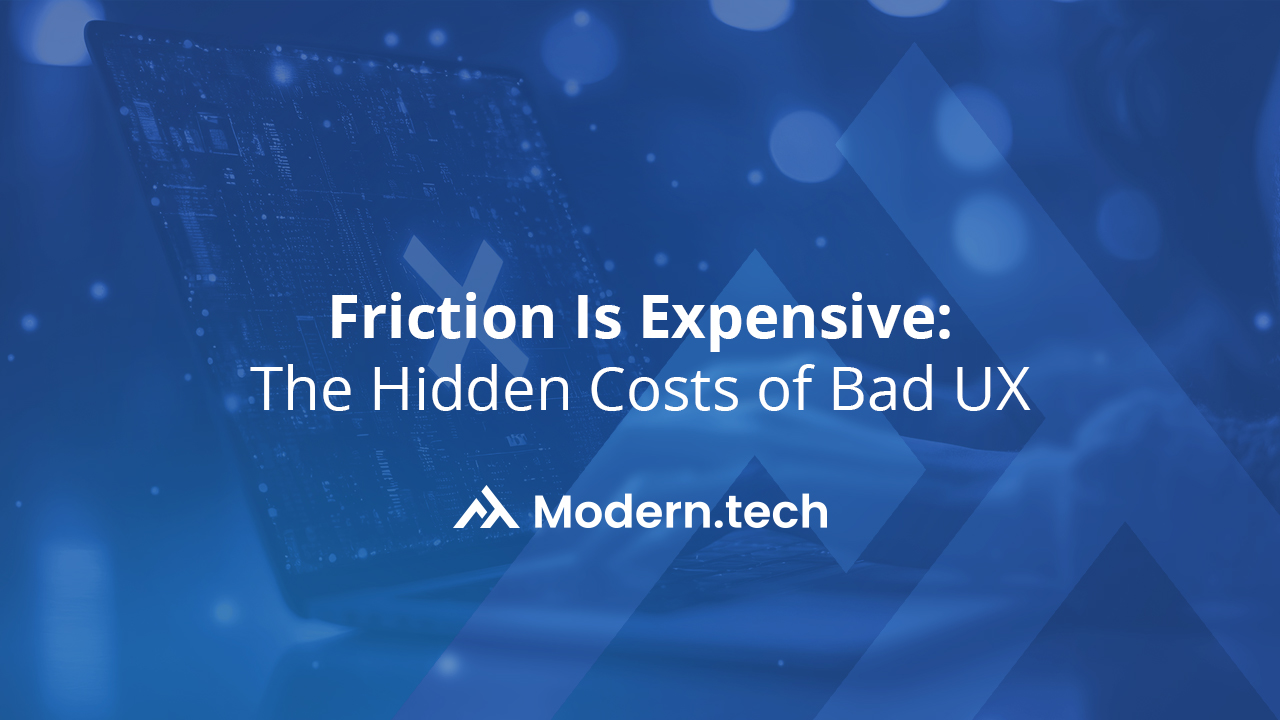Three seconds.
That’s all the time you have to make a first impression. According to Google, 53% of mobile users abandon a page that takes longer than three seconds to load.
Before we dive in, take a minute to try User Inyerface, an interactive challenge designed to frustrate you on purpose. It’s a brilliant (and painfully relatable) example of how bad UX can derail even the simplest task. Try navigating it, then come back. We’ll break down why friction like this is more than just annoying. It is expensive.
The impact of slow load times is just the tip of the iceberg. The cost of bad UX extends well beyond bounce rates and frustration. Consider this:
- 88% of online consumers are less likely to return to a site after a bad experience.
- 70% of customers abandon purchases due to poor UX.
- Forrester Research reports that a well-designed UX could improve conversion rates by up to 400%.
At Modern.tech, we understand that user experience (UX) is a critical component of your business strategy. In this article, we’ll delve into how UX friction impacts engagement, retention, and revenue, and what you can do to create seamless, profitable user journeys.
What Does Friction Look Like in UX?
UX friction is anything that slows users down, confuses them, or gets in the way of accomplishing what they came to do. It’s not always obvious, but it’s always costly.
You’ve seen it before:
- A confusing checkout flow that causes cart abandonment
- A signup form that asks for too much, too soon
- A dashboard cluttered with tabs you never use
These aren’t bugs. They’re design decisions that create unnecessary friction and quietly chip away at engagement, trust, and retention.
What’s worse is that these moments often go unnoticed internally. Teams may assume users are “just figuring it out” or that support can fill the gap. But as bounce rates rise and conversion rates fall, the story becomes clear: friction is a drag on your website’s performance.
The Cost of Bad UX
Friction in your user experience isn’t just a minor annoyance. It quietly erodes the performance of your product, your brand, and your bottom line. The signs are often spread out, but together they tell a clear story. Here’s where the cost shows up:
Lost Conversions: Every extra step, confusing form field, or delayed response creates an exit point. Users hesitate, bounce, or abandon the process completely. It’s no surprise that 70% of customers abandon purchases due to poor UX.
Lower Retention: When users struggle to complete basic tasks, they don’t just get frustrated. They stop coming back. A clunky or outdated interface sends the message that your product is not keeping up.
Higher Support Volume: Bad UX leads to more support tickets. When users can’t find what they need or complete simple actions, they turn to your team for help. This drives up service costs and adds unnecessary pressure to your staff.
Slower Internal Efficiency: UX friction affects your team too. Tools that are hard to navigate or poorly organized slow down workflows, reduce productivity, and increase the risk of errors.
Missed Opportunities: When your experience does not make it easy to explore, discover, or upgrade, users don’t. That means fewer upsells, fewer referrals, and limited growth.
UX and Conversion Rates: Why Design Is a Growth Lever
Too often, UX is seen as a surface-level concern. Something that gets polished once the real work is done. But in reality, design is not just decoration. It’s one of your strongest levers for growth.
A well-designed UX improves conversion rates. Simple.
- A clearer layout means fewer abandoned carts
- A streamlined onboarding flow means more completed signups
- A responsive mobile experience means fewer bounces
- An intuitive navigation means more engagement, deeper sessions, and higher retention
UX impacts every click, every scroll, and every decision your users make. It guides people toward value, reduces hesitation, and builds trust at every stage of the journey.
If you’re not treating UX as a business tool, you’re missing one of the most cost-effective ways to increase conversions without increasing ad spend.
What You Can Do About It
The good news? UX friction is fixable. You don’t need to redesign your entire product to see results. You just need to start viewing your user experience as a business priority and take action where it matters most.
Here’s where to begin:
- Audit Your Flows
Start by walking through your product like a new user. Where do things feel slow, unclear, or frustrating? Focus on key conversion paths like login, checkout, sign-up, or onboarding. Your data will show you where users are falling off.
- Use Analytics and Session Tracking
Bounce rates and heatmaps reveal a lot. Combine quantitative tools that provide real user feedback to understand what’s working and what needs improvement.
- Prioritize Mobile
Mobile-first is no longer optional. If your experience is not fast, clear, and easy to use on mobile, you are losing users.
- Simplify the Journey
Fewer steps, clearer calls to action, and less decision fatigue all lead to better outcomes. Make it as easy as possible for users to complete the task they came to do.
- Test with Real Users
Before launching something new, validate it with actual users. Even a small round of usability testing can reveal issues early and save time later.
How We Approach UX
At Modern.tech, we believe UX is not just a step in the process. It is part of everything we build, from the first prototype to the final release.
Our approach starts with listening. Before we write a single line of code, we spend time with users, stakeholders, and teams to understand how people actually work. We uncover what matters, what gets in their way, and where the product can improve.
From there, we move fast with intention:
- We prototype early
- We validate with real users
- We design for clarity, not complexity
- We connect experience to business goals
This mindset has helped us build tools that people actually want to use. From real estate platforms to internal systems, we help teams simplify complexity, reduce friction, and grow with confidence by putting UX at the center.
If your product feels weighed down by friction, you may not need a full rebuild. You may just need a partner who can help you see what is getting in the way and fix it before it slows you down.
Fix the Friction. Unlock the Value.
Bad UX is not just a usability issue. It is a silent cost that shows up in missed conversions, increased support load, slower workflows, and lost trust. Friction in your product experience rarely announces itself, but it always adds up. The good news is that improving UX does not always require a full redesign. Small, focused changes in the right places can lead to meaningful impact. At Modern.tech, we help teams uncover hidden friction, streamline experiences, and build products that perform better and grow faster.
If you are ready to turn UX into a business advantage, let’s talk.

